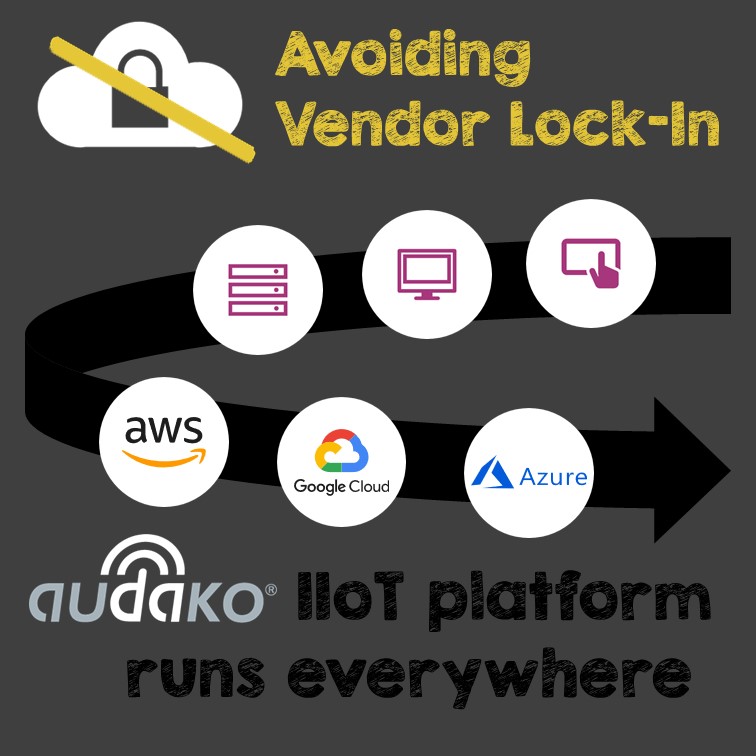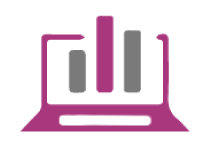audako IIoT platform for multi-cloud applications with high security and flexibility

Which is better?
Does a multi-cloud strategy for IIoT applications with public cloud offerings, such as those of hyperscalers (e.g., Amazon Web Services (AWS), Microsoft Azure, and Google Cloud Platform) make the most sense for our business? Supposedly more services, high availability and no vendor dependency. But doesn't using multiple cloud providers pose an increased security risk and using an on premise model alone might be a better choice after all? So what to do? These questions have certainly been asked by almost every company working with IIoT solutions, i.e. the networking of all plants, egde devices and sensors via the Internet. In the process, vast amounts of data (Big Data) are stored and processed in a cloud (cloud computing).
The widespread use of IIoT applications and cloud computing has greatly changed the data traffic in enterprise networks. The enormous volumes of data that companies exchange on the Internet as a result of increased digitization are no longer sustainable with conventional networks - only intelligent analysis and processing of these data volumes makes this data valuable and usable (smart data). To do this, companies need not only the right software, but also enormous computing power. audako IIoT platform makes it possible to efficiently manage, analyze and visualize large amounts of data - in all clouds.
Nowadays, the trend is towards multi-cloud, which means parallel use of different private and public cloud solutions. The multi-cloud solution represents a kind of update of the hybrid cloud model, in which only the private cloud in the company's own data center is supplemented by resources from a public cloud. IDG Research Services' Internet of Things 2019/2020 study shows that a quarter of companies each value multi-cloud capability (27 percent) as a feature of an IIoT platform for networking infrastructures. The rise of multi-cloud environments presents entirely new types of IT security challenges.
In this blog post, we would like to show readers the unimagined possibilities of the audako IIoT platform in a multi-cloud environment and provide food for thought to rethink previous IT solution structures or identify new possibilities for designing an IT architecture.
The cloud market: Unintended dependency through hyperscalers
All three major hyperscalers in the cloud market have established their IIoT solutions on the market and many other solutions and offerings on the IIoT market use the hyperscalers' portfolio of offerings as a basis. The individual IIoT building blocks of the big three are each available exclusively in the respective cloud. Anyone who builds their own IIoT solution around one of these proprietary cloud-only offerings risks vendor lock-in and makes themselves dependent on the services of the American hyperscalers. What often starts out as a cost-effective and quick entry into an own IIoT solution then often turns out to be difficult, complex, cost-intensive and risky. From the point of view of data and, in particular, data protection, companies have also been groping in the dark since the end of the Privacy Shield in terms of transatlantic data transfer or implementation of the EU DGSVO. Actual legal certainty will only have to be restored by the courts in the future.
Freedom is what audako looks like!
As an industry-independent IIoT platform, audako does not depend on any cloud services and can still be operated simultaneously in almost any cloud - but especially also with the three major hyperscalers. Unlike many offerings on the market, audako is available to customers as both a license (on premise) and cloud subscription. With the license variant, the customer can choose the operating platform himself - regardless of whether on his own systems, in a smaller data center or at one of the hyperscalers AWS, Azure or Google. Alternatively, the customer can choose to operate his audako instance from the audako cloud itself - certified operation in accordance with ISO 27001; operators of critical infrastructures in particular usually opt for this variant. Alternative hybrid scenarios also pose no problem for audako with its highly scalable and modular approach.
In the course of a multi-cloud strategy, companies or public institutions can use the audako IIoT platform to design their IT infrastructure all the way to the multi-cloud. audako not only leaves you the data sovereignty, but also the freedom to decide which applications should run via a public cloud, for example. Thus, audako IIoT platform can connect existing systems with cloud offerings from hyperscalers to on premise and enable switching between clouds at any time.
The collected IIoT data streams can also be moved between different operating platforms, because audako does not use any of the proprietary IIoT solutions to store them, but relies here on an open and freely available database. Regardless of how regulatory requirements change in the future, for example with regard to data protection, you can react to this at any time with audako and change your operating platform at short notice and at any time.
Our customers can connect multiple cloud services and on premise applications to a common central cloud. They can use services, IIoT applications and infrastructures on the cloud architectures of different providers or on premise in parallel and thus act independently of a single provider. The multi-cloud is managed centrally via the audako IIoT platform, which bundles the management of all services and IIoT solutions. This enables the company itself to implement projects or changes quickly and flexibly.
The advantages of an audako multi-cloud solution
Increase scalability
Scalability is only made possible by micro services. audako scales each project in a multi-cloud architecture to the maximum available size to meet the customer's requirements. If additional computing power is needed in certain situations, it can be easily added. Data exchange standards adhered to At the IIoT level, proven data exchange protocols such as OPC UA, MQTT or REST API are used. They are responsible for the extensive transfer of data in real time to the cloud. In this context, the amount of data per day can be several hundred gigabytes, which accumulates in a multi-cloud environment and converges in the cloud.
Avoid vendor lock-in
No company is dependent on services from one cloud provider. If, for example, a provider is no longer cost-efficient, performant or available, you can conveniently and easily switch to another provider. This is what makes audako Multi-Cloud so attractive for the IT infrastructure and also prevents vendor lock-in. Dependency can be minimized at the same time by using different providers in parallel.
Data protection, compliance & IT security combined
With audako, increased data security is achieved in a multi-cloud infrastructure. audako unifies the different data protection and data security concepts that result from many different individual provider concepts, taking into account the company's compliance guidelines, which may have to be reconciled with the providers' different data protection concepts.
Central management
The management of data between the different cloud services and the multi-cloud infrastructure as such, can become a major challenge. This is because the higher the number of providers, cloud models and on premise applications used, the more complex the management of the complete solution can become. High costs can arise for the greater effort of administration, elimination of sources of error and billing of services due to the use of different cloud service providers. audako provides a remedy for IT management. Thanks to centralized control, permanent monitoring and simplification of planning processes can significantly reduce administration costs.
High performance and fail-safe
audako guarantees high performance and fail-safety in a multi-cloud environment. Our high-performance and highly scalable database is ready to receive huge amounts of process data (Big Data) at the shortest intervals from the various applications in the multi-cloud infrastructure. These are condensed "in-memory" according to freely definable intervals or provided pre-compressed for visualization, evaluation and analysis (Smart Data). If one resource fails, it is possible to switch to another, which reduces the risk of the entire IT system being affected by the failure. The IT resource can be optimized as needed, for example, if a project requires more computing power, it can remain hosted with an operator that meets the requirements and another less demanding application can be run with a less expensive provider. This is easy on the budget and increases the performance of the applications.
Maximum flexibility
audako IIoT platform can increase flexibility within a multi-cloud infrastructure. Any number of applications or any cloud providers and services can be flexibly selected and interconnected in audako. Projects and other applications can switch between cloud services as desired and easily. You can separate applications from any type of workloads or storage capacities at any time. If IIoT solutions need to be hosted on-premises to ensure security, performance and reliability, this scenario is not a problem for an audako multi-cloud environment (e.g. projects in locations with unreliable network connectivity). Or there are multiple international projects that need to be hosted on local cloud services to comply with data protection regulations. Integrating and connecting IIoT solutions with existing enterprise and operating systems into an audako multi-cloud is enabled by vendor neutrality. The option to deploy audako IIoT platform services with existing service providers facilitates the management of the multiple overall solution. With audako in place, you succeed in a multi-cloud strategy so that customer and regional requirements can be better addressed.
Faster and better with 5G
Unlike 4G, 5G offers sufficient power for intensive cloud computing as required in a multi-cloud structure. The introduction of 5G mobile technology heralds a new era of connectivity. 5G has faster speeds, higher bandwidths and lower latency, this enables improved cloud computing through faster uploads and downloads. Businesses dealing with data-intensive projects will notice significant improvements to work on data- and graphics-intensive workloads without delay. Incorporating a 5G network infrastructure into the overall multi-cloud is possible with audako, centralized compute and storage resources in the data center are improved and also distributed throughout the network to fully realize the reduced latency of 5G. With the new cellular standard 5G, the Machine-Type Communication networks such as NB-IoT (Narrowband IoT) and LTE-M become available, which can be easily integrated into the audako multi-cloud environment.
The future belongs to multi-clouds
The audako multi-cloud service represents a solution to the problem that there is no central cloud service that is optimally suited for all deployment scenarios. "The future belongs to multi-clouds," according to a forecast by analyst firm IDC, as early as spring 2020. According to IDC, the trend is moving inexorably in the direction of multiple clouds, as more and more companies would use different cloud types or the services of different cloud providers. There is therefore a need for a central management service that meets regulatory requirements, ideally fulfills a specific application or service - and brings the various services and applications under "control and harmony". With audako you remain flexible. You have the option to choose an alternative hosting and to run the software on your own computing server via a license purchase, as you see fit. Customers also use audako as a combination solution in their multi-cloud strategy on the one hand as a cloud service or on premise application and on the other hand as a central management system for the entire multi-cloud infrastructure. audako multi-cloud offers the flexibility and independence of hyperscalers that companies need to manage their individual resources and challenges. These multi-clouds will become increasingly important in combination with other trends such as edge gateways, IIoT solutions and 5G, according to popular opinion. This will not only improve the multi-cloud way of working, but will also further drive the utility of cloud desktops and ultimately evolve the IT landscape. Further, we cover the entire stack of solutions needed on the journey to IIoT and 5G. We help customers with network transformation to a multi-cloud strategy, plus we have technical expertise to build a robust cloud environment. We have IIoT enabled devices such as data loggers and audako Egde Gateways that can be integrated into a multi-cloud solution. audako IIoT platform can be seen as an amalgamation of private, public, internal and edge implementations.



